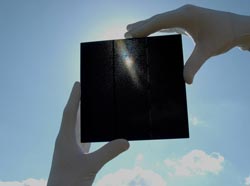21.0% record efficiency for large area (156 × 156 mm2) n-type EWT solar cell

The novel n-type EWT solar cell with 21% efficiency. Foto: ISFH<br>
At the 37th IEEE Photovoltaic Specialist Conference, which took place in Seattle in June 2011, ISFH and Q-Cells already presented small n-type EWT solar cells with an efficiency of 21.6% and an area of (20 × 20) mm2. The cell process is based on monocrystalline Czochralski n-type silicon.
The boron-doped emitter is defined with laser structuring and is passivated optimally with an aluminumoxide-siliconnitride double layer. ISFH has now scaled up the solar cell production processes to large wafer formats. A novel back contact design with four busbars has been developed, which reduces the finger length to about 50 mm and makes it possible to realize on this large cell area a metalization with a solar cell resitivity contribution less than 0.5 Ohm·cm2.
The project team at ISFH with project manager Till Brendemühl and the R&D team at Q-Cells SE are particularly pleased with the performance of the best (156 × 156) mm2 area solar cell, which has an efficiency of 21.0%, a Jsc of 40.5 mA/cm2, a Voc of 667 mV, and a fill factor of 77.7%.
The solar cells have been measured with a class A sun simulator in the characterization lab at Q-Cells SE, using a measuring chuck developed at ISFH. The measurement has been corrected considering the spectral mismatch.
“This cell type still has the potential for further improvements. We are confident to reach even higher efficiencies” says physicist Fabian Kiefer, who is developing back-contacted solar cells as part of his PhD thesis.
“Our goal is to simplify the production process significantly, while keeping the efficiencies above 21.0% on large cell area” says Prof. Dr. Nils-Peter Harder, head of the group.
Media Contact
More Information:
http://www.isfh.de/All latest news from the category: Power and Electrical Engineering
This topic covers issues related to energy generation, conversion, transportation and consumption and how the industry is addressing the challenge of energy efficiency in general.
innovations-report provides in-depth and informative reports and articles on subjects ranging from wind energy, fuel cell technology, solar energy, geothermal energy, petroleum, gas, nuclear engineering, alternative energy and energy efficiency to fusion, hydrogen and superconductor technologies.
Newest articles

Sea slugs inspire highly stretchable biomedical sensor
USC Viterbi School of Engineering researcher Hangbo Zhao presents findings on highly stretchable and customizable microneedles for application in fields including neuroscience, tissue engineering, and wearable bioelectronics. The revolution in…

Twisting and binding matter waves with photons in a cavity
Precisely measuring the energy states of individual atoms has been a historical challenge for physicists due to atomic recoil. When an atom interacts with a photon, the atom “recoils” in…

Nanotubes, nanoparticles, and antibodies detect tiny amounts of fentanyl
New sensor is six orders of magnitude more sensitive than the next best thing. A research team at Pitt led by Alexander Star, a chemistry professor in the Kenneth P. Dietrich…





















